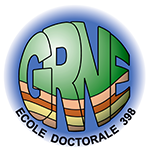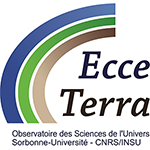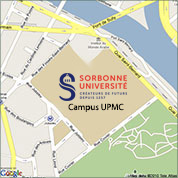Séminaire ISTeP - Evgueni Burov
(ISTeP)
Asymmetric three-dimensional topography over mantle plumes
The role of mantle–lithosphere interactions in shaping surface topography has long been debated. In general it is supposed that mantle plumes and vertical mantle flows result in axisymmetric, long-wavelength topography, which strongly differs from the generally asymmetric short-wavelength topography created by intraplate tectonic forces.
However, identification of mantle-induced topography is difficult, especially in the continents. It can be argued therefore that complex brittle–ductile rheology and stratification of the continental lithosphere result in short-wavelength modulation and localization of deformation induced by mantle flow. This deformation should also be affected by far-field stresses and, hence, interplay with the ‘tectonic’ topography (for example, in the ‘active/passive’ rifting scenario).
Testing these ideas requires fully coupled three-dimensional numerical modelling of mantle–lithosphere interactions, which so far has not been possible owing to the conceptual and technical limitations of earlier approaches. Here we present new, ultra-high-resolution, three-dimensional numerical experiments on topography over mantle plumes, incorporating a weakly pre-stressed (ultra-slow spreading), rheologically realistic lithosphere. The results show complex surface evolution, which is very different from the smooth, radially symmetric patterns usually assumed as the canonical surface signature of mantle upwellings. In particular, the topography exhibits strongly asymmetric, small-scale, three-dimensional features, which include narrow and wide rifts, flexural flank uplifts and fault structures. This suggests a dominant role for continental rheological structure and intra-plate stresses in controlling dynamic topography, mantle–lithosphere interactions, and continental break-up processes above mantle plumes.
23/10/2014 à 12h30, Salle de Conférences de l'UFR (46/56, 2ème étage)
Egalement dans la rubrique
- Séminaire ISTeP - Chrystèle Sanloup
- Séminaire ISTeP - Marco Scambelluri
- Séminaire ISTeP - Déborah Chavrit
- Séminaire ISTeP - Anne Le Friant
- Séminaire ISTeP - Pierre Valla
- Séminaire ISTeP - Ramadan Ghalayini
- Séminaire ISTeP - Matthias Delescluse
- Séminaire ISTeP - Séverine Moune
- Séminaire ISTeP - Lucie Tajcmanova
- Séminaire ISTeP - Gabriel Coelho
- Séminaire ISTeP - Laurie Bougeois
- Séminaire ISTeP - Jacques Touret
- Séminaire ISTeP - Sanae El Janyani
- Séminaire ISTeP - Arthur Paté
- Séminaire ISTeP - Nicolas Beaudoin
- Séminaire ISTeP - Kosuke Ueda
- Séminaire ISTeP - Ali Hannouche
- Séminaire ISTeP - Benjamin Cochain
- Séminaire ISTeP - Behzad Nasri
- Séminaire ISTeP - Daniel Pastor Galan
- Séminaire ISTeP - Sara Lafuerza Colas
- Séminaire ISTeP - Jean-Pierre Suc
- Séminaire ISTeP - Pierpaolo Zuddas
- Séminaire ISTeP - Agnès Elmaleh
- Séminaire ISTeP - John Wakabayashi
- Séminaire ISTeP - Jonas Ruh
- Séminaire ISTeP - Timm John
Chiffres clés (Mars 2025)
L'ISTeP comprend 131 membres dont :
Permanents (66)
- Professeurs : 17 (+2 PAST)
- Maîtres de conférence : 26
- Directeurs de recherche CNRS : 1
- Chargés de recherche CNRS : 1
- ITA : 19
Personnels non permanents (65)
- Collaborateurs bénévoles / émérites : 17
- Chaire de professeur junior : 1
- Enseignants-chercheurs contractuel : 2
- 1 MCF accueil en délégation
- ATER et Post-Docs : 9
- Doctorants : 32
- ITA-BIATSS : 3





